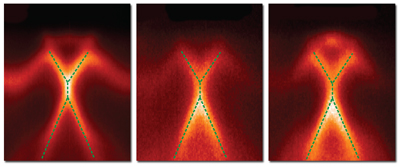Feb 7 2013
In bulk, topological insulators (TIs) are good insulators, but on their surface they act as metals, with a twist: the spin and direction of electrons moving across the surface of a TI are locked together. TIs offer unique opportunities to control electric currents and magnetism, and new research by a team of scientists from China and the U.S., working with Berkeley Lab’s Alexei Fedorov at beamline 12.0 at the Advanced Light Source, points to ways to manipulate their surface states.
 The hybrid band structure of the compound topological insulator bismuth telluride, thinly layered with pure bismuth, as drawn by ARPES: the relative intensity of the bands changes with increasing energy of x-ray photons from the Advanced Light Source (left to right). The unmoving vertical line that connects the apex of bismuth telluride’s surface valence band (below) with the apex of the hybrid band (above) is a sign of surface many-body interactions.
The hybrid band structure of the compound topological insulator bismuth telluride, thinly layered with pure bismuth, as drawn by ARPES: the relative intensity of the bands changes with increasing energy of x-ray photons from the Advanced Light Source (left to right). The unmoving vertical line that connects the apex of bismuth telluride’s surface valence band (below) with the apex of the hybrid band (above) is a sign of surface many-body interactions.
Graphene, a single layer of carbon atoms, shares an intriguing property with TIs. In both, their band structures – the energies at which electrons flow freely in a conduction band or are bound to atoms in a valence band – are quite unlike the overlapping bands of metals, the widely separated bands of insulators, or a semiconductor’s narrow energy gap between bands. In graphene and TIs, conduction and valence bands form cones that meet at a point, the Dirac point.
Here their resemblance ends. Graphene’s perfect cones give only a sketchy view of the real band structure: a deviation from perfectly straight lines shows up when all possible interactions of electrons on their way across the carbon-atom lattice are included – a process called “renormalization.” Renormalizing the electronic states near the Dirac point (in other words, drawing the tips of the cones) requires understanding the collective behavior of numerous electrons and positively charged holes (absences of electrons, also known as quasiparticles).
Renormalization has been observed in graphene, but not in TIs – until now, and doing it took a trick. The researchers studied different TI compounds using angle-resolved photoemission spectroscopy (ARPES) at beamline 12.0, which has the unique ability to image electronic band structures directly. They took spectra of two promising topological insulators, bismuth telluride and bismuth selenide.
TIs have two sets of band structures, echoing the difference between their bulk and surface properties, and when ARPES imaged the sample compounds “naked,” the bulk bands obscured the surface cones and Dirac points. But after layering films of pure bismuth, which is also a TI, onto the compounds, the pesky bulk bands vanished.
In one layered compound, bismuth on bismuth telluride, ARPES dramatically revealed the Dirac point — in fact two of them. Two sets of converging lines showed up, one meeting at the apex of bismuth telluride’s surface valence band and the other at a higher energy. A bright vertical line connected the tips of the two cones.
If the cones were really separated, the charged particles between them would have infinite velocity. But after analysis, the researchers determined that the ARPES spectrum was a hybrid, and that the tell-tale vertical line originated from many-body interactions that were the sign of the infinity-blocking renormalization they were seeking.
What makes many-body interactions difficult to detect in TIs is that, unlike graphene, their surface band structures are spin polarized, or “helical.” By hybridizing two especially well matched TIs and skewing their Dirac cones, the hidden renormalization has been found – in at least one TI structure.
More information about this research is at http://www.pnas.org/content/early/2013/01/30/1218104110.abstract.